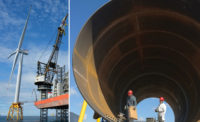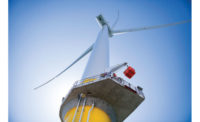Europe set a market lead in offshore wind power development, but China is quickly eroding it, experts told attendees of a major global industry conference last month in London. As these markets mature, presenters added, developers are looking increasingly at vast potential offered by emerging economies and deployment of floating wind generation to exploit untapped resources in deep waters.
With pressure to decarbonize national economies, “renewables, as a whole…have really reached a turning point,” Imogen Brown, energy analyst with BloombergNEF, told online delegates at the Global Offshore Wind 2020 conference held last month by trade group RenewablesUK. Offshore wind power still is “fairly nascent, ” she added, but with large growth prospects, “it’s a good time to be part of it.”
Surrounded by seas, the U.K. was quick to take the plunge into offshore wind power, and it continues to invest heavily in the sector. With 10.4 GW installed and 4 GW in construction, Britain is the world’s largest offshore wind market, aiming to reach 40 GW by 2030, including 1 GW of floating production, according to Jamie Cribb, a trade manager at the Dept. of International Trade.
But China is gaining fast, despite its later start in the market than Europe. The Asian power already ranks third in terms of installed capacity behind the U.K. and Germany, sais Qin Haiyan general secretary of the Chinese Wind Energy Association. In the first half of 2020, China connected 1 GW of capacity to the grid and began 12 GW of new construction as of September. Last year, 2.5 GW were installed, raising the total to 7 GW.
Including onshore projects, China’s wind energy capacity reached 236 GW, accounting for 5.5% of total generation, added Qin.
Global Gale
Having developed expertise and supply chains in more advanced markets, developers see huge potential across the globe. Argentina alone has a potential of more than 1,900 GW of offshore wind capacity, according to the World Bank, launching a development program in March 2019 to nurture emerging markets and broadly, to “build a pipeline of bankable projects,” said Mark Leybourne, a bank senior energy specialist.
Around 7,000 GW of projects is potentially up for development among 24 countries taking part in the bank’s recent “virtual study tour.” The bank’s five-year program aims to help develop local capacity and prepare required project financing in collaboration with the International Finance Corp., its private sector loan affiliate.
Other target markets globally include Brazil with around 1,200 GW potential, followed by South Africa with 646 GW, according to the bank. Other developing markets include Vietnam (474 GW), Uruguay (275 GW) and Egypt, with 236 GW potential.
As the industry moves into new geographies, they are also going deeper. With four-fifths of offshore wind resources estimated to be in waters more than 60 m deep, floating platforms represent “the next chapter of the offshore industry,” said Una Brosnan, offshore new markets manager of Dublin-based developer Mainstream Renewable Power.
By 2030, floating turbines could generate more than 6 GW of power, according to a forecast by the Global Wind Energy Council. But to reach that point, the industry urgently needs commercial scale projects, as well as clear regulation and investment in supply chains, said Alfonso Montero, project services director at Spain’s Iberdrola Renewables.
Commercial Scale
Keen to reach commercial scale activity soon, he urged the industry to standardize technologies.
But Marcus Thor, project director of Stockholm-based floating platform developer Hexion, wants to see “a few more technologies to choose from," adding that "if there’s one industry that can scale up at pace it’s floating wind.”
There are about 40 concepts at various development stages, according to Adrian de Andres, head of offshore renewables development at energy consultant Xdus Group, who also sees a need for consolidation in the technology.
While Europe currently leads in floating platform development, “the race for the first commercial projects is on,” said Brosnan. “We are going to see a very strong push back from Asia.”
Meanwhile, Scotland now represents “the first commercial scale opportunity in the world,” according to de Andres. Competition to win leases for 17 offshore Scottish sites is due to start this year for up to 10 GW of capacity. Of that, 5 GW could be floating, said de Andres.
Many oil and gas companies now decommissioning North Sea fossil fuel facilities will be among the lease bidders, he said, adding that they “see floating wind as a logical step in their energy transition.”






Post a comment to this article
Report Abusive Comment